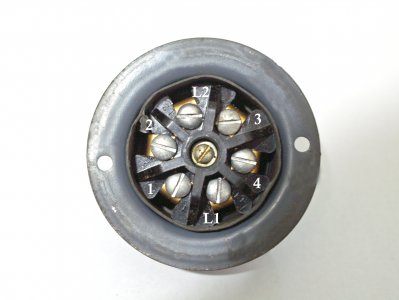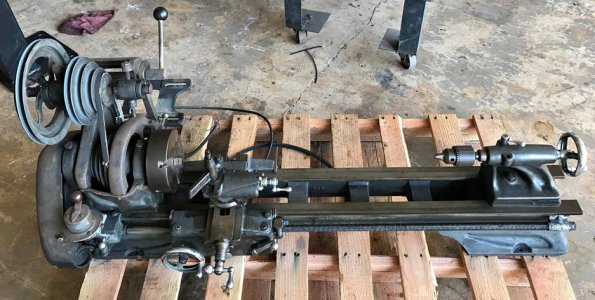I was recently given an Atlas TV48 lathe. It seems to be in good shape, except that the motor was missing and the wiring cut off short. Does anyone have a schematic or wiring diagram of how the motor and forward/reverse switch are connected together? It has a Furness L143 C switch. It has 6 terminals labeled L1, L2, 1, 2, 3, 4.
-
Welcome back Guest! Did you know you can mentor other members here at H-M? If not, please check out our Relaunch of Hobby Machinist Mentoring Program!
You are using an out of date browser. It may not display this or other websites correctly.
You should upgrade or use an alternative browser.
You should upgrade or use an alternative browser.
Atlas Forward/Reverse Switch
- Thread starter D.Moon
- Start date
- Joined
- Apr 30, 2015
- Messages
- 11,328
Do you have a motor, or are you shopping for one?
Fractional horsepower motors have different wiring arrangements depending on brand and model
Dayton motors can be the most difficult to wire for reversing operation- try not to get a Dayton if possible
-Mark
Fractional horsepower motors have different wiring arrangements depending on brand and model
Dayton motors can be the most difficult to wire for reversing operation- try not to get a Dayton if possible
-Mark
- Joined
- Apr 30, 2015
- Messages
- 11,328
You can't run a dc motor directly off the ac line. At minimum you would need to rectify the ac power OR provide a dc motor controller like KB electronics or the original treadmill controller if you have it.
Using just rectified ac power you would not have good speed regulation with varying load, so having a true electronic controller is recommended
-Mark
Using just rectified ac power you would not have good speed regulation with varying load, so having a true electronic controller is recommended
-Mark
- Joined
- Feb 2, 2013
- Messages
- 3,627
Directional control is as simple as reversing the polarity
- Joined
- Apr 30, 2015
- Messages
- 11,328
OK, you can connect the switch as a DPDT to reverse the motor polarity. You just need to ring it out with a ohmmeter to id the switch contacts.
Be aware however: switching the motor while under power could blow the controller's output stage, depending on the type of controller. Old style SCR type units are more rugged. Some of the older treadmills had those. They usually have five TO-220 power tab devices on a common heatsink.
On the other hand...
More modern mosfet types are more prone to voltage spikes and damage though, so you need to use caution with those. A moment of forgetfulness and there goes your controller.
But, if you do have a mosfet type controller and blow it up, you can change to a SCR type like KB electronics or Dart controls
Be aware however: switching the motor while under power could blow the controller's output stage, depending on the type of controller. Old style SCR type units are more rugged. Some of the older treadmills had those. They usually have five TO-220 power tab devices on a common heatsink.
On the other hand...
More modern mosfet types are more prone to voltage spikes and damage though, so you need to use caution with those. A moment of forgetfulness and there goes your controller.
But, if you do have a mosfet type controller and blow it up, you can change to a SCR type like KB electronics or Dart controls
Last edited:
- Joined
- Apr 30, 2015
- Messages
- 11,328
Often times for metric threading the spindle/carriage needs to be backed up repeatedly to the starting point without disengaging the half-nuts
In this case the backgears are used or the machine is set for a low speed so the risk of dropping a chuck is minimal
In this case the backgears are used or the machine is set for a low speed so the risk of dropping a chuck is minimal
Last edited:
- Joined
- Dec 25, 2011
- Messages
- 10,512
If considering using a variable speed DC motor on the lathe, first thing that you need to determine is whether or not the drum switch that you want to use is suitable for 3-Phase and DC motor operation. To determine this, fasten the switch to something either bolted to a bench or somehow fastened down so that you can operate the switch one-handed (not having to hold the switch down with one hand while operating it with the other hand). Operate the switch to one of the two ON positions (call it Forward for the moment). Now try to change the switch to Reverse in one continuous motion (without momentarily stopping in OFF). If you can do this, do NOT use the switch on anything except a single phase motor. It is NOT safe for use on either a DC or a 3-phase motor.
The reason that this is so is that a single phase motor when running in either direction (assuming that the centrifugal start switch is working) will have the START winding disconnected by the centrifugal START switch and throwing the control switch directly from FORWARD to REVERSE will do nothing except momentarily remove power from the RUN winding(s). The motor will continue to run in whichever direction it was running before you changed the switch. The DC or 3-phase AC motor, on the other hand, will create much hate and discontent as it tries to go from full speed in one direction to full speed in the other without being allowed to momentarily stop before starting in the other direction. A rotary, lever or toggle switch that is made to operate a reversible motor has a mechanism built into it that basically forces you to remove your hand from the bat/lever/knob while it is in the OFF position before you can throw the switch on over to the opposite setting. Determine this before you even bother to try to figure out how to wire your drum switch. If the switch came from Atlas, it is probably OK.
We have switch wiring diagrams for a lot of motor switches. but it isn't worth looking it up until you have tested the switch mechanically.
The reason that this is so is that a single phase motor when running in either direction (assuming that the centrifugal start switch is working) will have the START winding disconnected by the centrifugal START switch and throwing the control switch directly from FORWARD to REVERSE will do nothing except momentarily remove power from the RUN winding(s). The motor will continue to run in whichever direction it was running before you changed the switch. The DC or 3-phase AC motor, on the other hand, will create much hate and discontent as it tries to go from full speed in one direction to full speed in the other without being allowed to momentarily stop before starting in the other direction. A rotary, lever or toggle switch that is made to operate a reversible motor has a mechanism built into it that basically forces you to remove your hand from the bat/lever/knob while it is in the OFF position before you can throw the switch on over to the opposite setting. Determine this before you even bother to try to figure out how to wire your drum switch. If the switch came from Atlas, it is probably OK.
We have switch wiring diagrams for a lot of motor switches. but it isn't worth looking it up until you have tested the switch mechanically.




